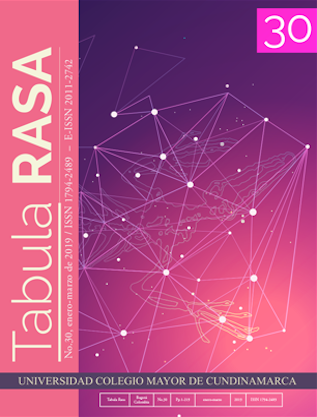Water belongs to the people, not Belo Monte : dams and harm on affected population’s social networks as represented in amazonian arpilleras.
El agua es de los pueblos y no de Belo Monte : represas y pérdidas de redes de sociabilidad de las poblaciones afectadas representadas en arpilleras amazónicas.
Show authors biography
This paper addresses the effects of sociability mesh among populations affected by Usina Hidroelétrica Belo Monte (Belo Monte Hydroelectric Power Plant –PA). The loss of sociability mesh is depicted on Amazonian arpilleras. ftis is a textile handicraft technique made by women from Isla Negra (Chile), which reemerged as an instrument of resistance during Pinochet’s dictatorship (1973-1990). Arpillera workshops were based on the Solidarity Vicarship, a branch of the Catholic Church engaged in the defence of human rights. In Brazil, their offices were brought up by the Movement of Dam-Affected People (2012) as a means to report breaches on affected populations’ rights because of dams. According to the Report of the Human Rights Defence Council (2010), considering populations affected, women show an extreme vulnerability. The MAB’s Women Collective, in an effort to visibilize socioeconomic losses and their rights’ breach, set up Arpillera workshops in nine states across the country aiming to train people on this work. Arpilleras crafted were exhibited at the Latin American Memorial (2015) and now enjoy international recognition through Roberta Bacic’s curatorial work; also Brazilian arpilleras are indexed in Conflict Textiles. ftis paper analyses the effects of uprooting and breaking ties of vicinity among Altamira communities, who used to live in stilt houses and have now been relocated to the Jatobá development. A part of this history is recorded on arpilleras, narratives embroidered by women who turned needlework into a transgressive action.
Article visits 181 | PDF visits 83
Downloads
- Agosin, M. (2008). Tapestries of Hope, Threads of Love, The Arpillera movement in Chile 1974-1994. 2.a ed. EE. UU.: Rowman & Littlefeld Publishers.
- Bacic, R. (2012). História das arpilleras. Catalogo da exposição Arpilleras da resistência politica chilena. Rio de Janeiro/ Brasília: Projeto Marcas da Memória/ Ministério da Justiça/ Comissão de Anistia.
- Bacic, R. (2008). Arpilleras que claman, cantan, denuncian e interpelan. Hechos del Callejón, (42), 20-22.
- Barbosa, A. S. (2015). A cada dia, um morador perde o direito aqui em Altamira. Dossiê Belo Monte. ISA. s/l, jun. 2015. https://www.socioambiental.org/sites/blog.socioambiental.org/files/dossie-belo-monte-site.pdf
- Brasil. Ministério de Justicia/ Comisión de Amnistía/Proyecto Marcas de la Memoria. (2012). Catálogo Arpilleras de la resistencia política chilena. Brasília. Disponible en http://www.justica.gov.br/central-de-conteudo/anistia/anexos/catalogo-arpilleras-1.pdf
- Brasil. Ministério da Integração Nacional. Secretaria de Infraestrutura Hídrica. Unidade de Gerenciamento do Proágua/Semi-arido. (2005). Diretrizes ambientais para projeto e construção de represas e operação de reservatórios. Brasília: Bárbara Bela Editora Gráfica. http://www.mi.gov.br/documents/10157/3678963/Diretrizes+ambientais+para+projeto+e+construcao+de+represas+e+operacao+de+reservatorios.pdf/7b333ac8-f12b-45db-903d-4e8b4d42b266
- Brasil. Ministério do Planejamento. (2016). 2º Balanço do PAC (2015-2018). Ano I, Brasília. http://www.pac.gov.br/pub/up/relatorio/23216159149151fbfbcedb1d57dff510.pdf
- CDDPH. (2010). Relatório da Comissão Especial Atingidos por Represas. Resoluções nºs 26/06, 31/06, 01/07, 02/07, 05/07. Brasília. Disponible en http://www.mabnacional.org.br/sites/default/files/Relat%C3%B3rio%20Final_0.pdf
- Norte Energia S.A. (2011). Projeto Básico Ambiental da Usina Hidrelétrica Belo Monte: Planos, Programas e Projetos. volumen II, tomos 1, 2.
- Galeano, E. (1997). Mulheres. Porto Alegre: L & PM.
- Geertz, C. (2008). A interpretação das culturas. Rio de Janeiro: LTC.
- Gondim, S. M. G. (2003). Grupos focais como técnica de investigação qualitativa: desafios metodológicos. Paidéia, 12(24), 149, 161.
- Hernández, A. P. & Berenguel, M. V. (2010). Las arpilleras, una alternativa textil femenina de participación y resistencia social. En Carmen Gregório Gil y Patricia Blanco, ¿Por qué tienen que decir que somos diferentes? Las mujeres inmigrantes, sujetos de acción política. s/l: Otras.
- Januzzi, L. (2015, julio). Arpilleras. Bordando a resistencia. Revista Radis - comunicação e Saúde. Fundação Osvaldo Cruz, (154).
- Leite, L. (2015, junio). Belo Monte: os filhos da barragem Vozes do Xingu: Dossiê Belo Monte. ISA, s/l. Disponible en: https://www.socioambiental.org/sites/blog.socioambiental.org/files/dossie-belo-monte-site.pdf
- MAB / Conflict Textiles (2015). Catálogo Arpilleras: bordando a resistencia. São Paulo: Prometo Gráfico Zol Design.
- Moya-Raggio, E. (1984). Arpilleras: Chilean culture of resistance. Feminist Studies, 10(2), University of Maryland.
- Palmquist, H. (2015). Remoção forçada de ribeirinhos pelo Belo Monte provoca desastre social. En Altamira. Dossiê Belo Monte. ISA, s/l, jun. 2015. https://www.socioambiental.org/sites/blog.socioambiental.org/files/dossie-belo-monte-site.pdf
- Penzani, R. (2015, abril). A revolução será costurada. Revista da Cultura, (93), Ed. Livraria Cultura.
- Pereira, R. (2016, 12 de abril). Para se livrar das contas, morador coloca casa à venda. Estadão. São Paulo. Disponible en http://economia.estadao.com.br/noticias/geral,altamira-enfrenta-a-ressaca-de-belo-monte,10000024436
- Tuan, Y. F. (1980). Topofilia: um estudo da percepção, atitudes e valores do meio ambiente. São Paulo: Difel.
- Weissermel, S. (2015, junio). Consequências das condicionantes de remoção para os atingidos no âmbito do reassentamento urbano coletivo. Dossiê Belo Monte. ISA. https://www.socioambiental.org/sites/blog.socioambiental.org/files/dossie-belo-monte-site.pdf
- Young, J. E. (2005). Living with the Fabric Arts of Memory. En Ariel Zeitlin Cooke y Marsha Macdowell (Eds.), Weavings of War: Fabrics of memory (pp. 31-36). Michigan: Michigan State University Museum.




